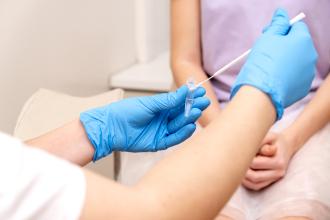Doxycycline: "New" treatment of choice for genital chlamydia infections
In the 1998 Canadian Sexually Transmitted Disease (STD) Guidelines, azithromycin (1.0 gm orally as a single dose) replaced doxycycline (100 mg orally twice a day for 7 days) as treatment of choice for chlamydia infection.[1] Azithromycin was also listed before doxycycline for non-gonococcal urethritis (NGU), muco-purulent cervicitis (MPC) and as co-treatment with cefixime for uncomplicated gonorrhea. Sexual contacts are traditionally treated with the same medication as index cases. In the 1998 and 2002 US guidelines, however, azithromycin and doxycycline were equivalent first-line treatments for these conditions (www.cdc.gov/STD/treatment). From 1998, azithromycin was provided free of charge from BCCDC for the treatment of laboratory-confirmed cases of genital chlamydia infections and their contacts.
Important research findings dictate a return to doxycycline as the treatment of choice for uncomplicated urethral, cervical, and oral chlamydia infections, for NGU and MPC, and as co-treatment for uncomplicated gonorrhea.
In research studies, doxycycline and azithromycin have been shown to be equivalent for the treatment of genital chlamydia infection.[2] A meta-analysis of randomized clinical trials showed equal efficacy with no difference in adverse events.[2]
In day-to-day usage, doxycycline and azithromycin also show equivalent outcomes. In a use-effectiveness study at seven public health clinics, doxycycline and azithromycin were equivalent for treating genital chlamydia infection and preventing recurrences.[3] Studies have shown chlamydia cure rates of 98% with 5 days of doxycycline therapy or 8 to 10 of the prescribed 14 doxycycline pills.[2]
Azithromycin and other longer-acting macrolides have been associated with S. pnuemoniae resistance in several countries including Taiwan and the United States.[4] In Canada, macrolide-resistance in S. pnuemoniae increased by 30% between 1995 and 1998.[4] S. pnuemonaie is an important cause of adult community-acquired pneumonia, meningitis, bacteremia, and otitis media.[4] Another reason for concern is azithromycin resistance in T. pallidum, the causative agent for syphilis. In a recent study of T. pallidum strains from the US and Ireland, 25% overall (33/132) were found to be macrolide-resistant.[5] This is important because the treatment of chlamydia, NGU, MPC, and gonorrhea is meant to abort incubating syphilis. Finally, there is recent data from the US showing gonorrhea resistance to azithromycin.[6]
A course of azithromycin costs the British Columbia health care system $18.15, whereas a course of doxycycline is $4.06. Cost should not be a factor when the more expensive medication is more effective but, in this case, the cheaper medication is equal or superior.
For these reasons, the STD/AIDS Control Program is recommending that doxycycline be used as first-line treatment of choice for chlamydia, NGU, MPC, and the index case’s contacts. We also recommend doxycycline as the preferred co-treatment with cefixime for uncomplicated gonorrhea. Azithromycin will continue to be available for persons who cannot complete a course of doxycycline and for those allergic to tetracyclines. In pregnancy and for nursing mothers, we continue to recommend amoxicillin or erythromycin. The Canadian STD Guidelines are currently under revision.
—Michael L. Rekart, MD, DTM&H, MHSc, FRCPC
BC Centre for Disease Control
References
1. Health Canada. Canadian STD Guidelines. 1998. www.hc-sc.gc.ca/pphb-dgs psp/publicat/std-mts98/index.html (accessed 10 September 2004).
2. Lau C-Y, Qureshi AK. Azithromycin versus doxycycline for genital chlamydial infections: A meta-analysis of randomized clinical trials. Sex Transm Dis 2002;29:497-502. PubMed Abstract Full Text
3. Hillis SD, Coles FB, Litchfield B, et al. Doxycycline and azithromycin for prevention of chlamydial persistence or recurrence one month after treatment in women: A use-effectiveness study in public health settings. Sex Transm Dis 1998;25:5-11. PubMed Abstract
4. Conly JM, Johnston BL. Macrolide resistance in Streptococcus pneumoniae: Fallacy or fact? Can J Infect Dis 2002;13:13-16.
5. Lukehart SA, Godornes C, Molini BJ, et al. Macrolide resistance in Treponema pallidum in the Untied States and Ireland. N Engl J Med 2004;351:154-158. PubMed Citation Full Text
6. McLean CA, Wang SA, Hoff GL, et al. The emergence of Neisseria gonorrhoeae with decreased susceptibility to azithromycin in Kansas City, Missouri, 1999 to 2000. Sex Transm Dis 2004;31:73-78. PubMed Abstract Full Text

